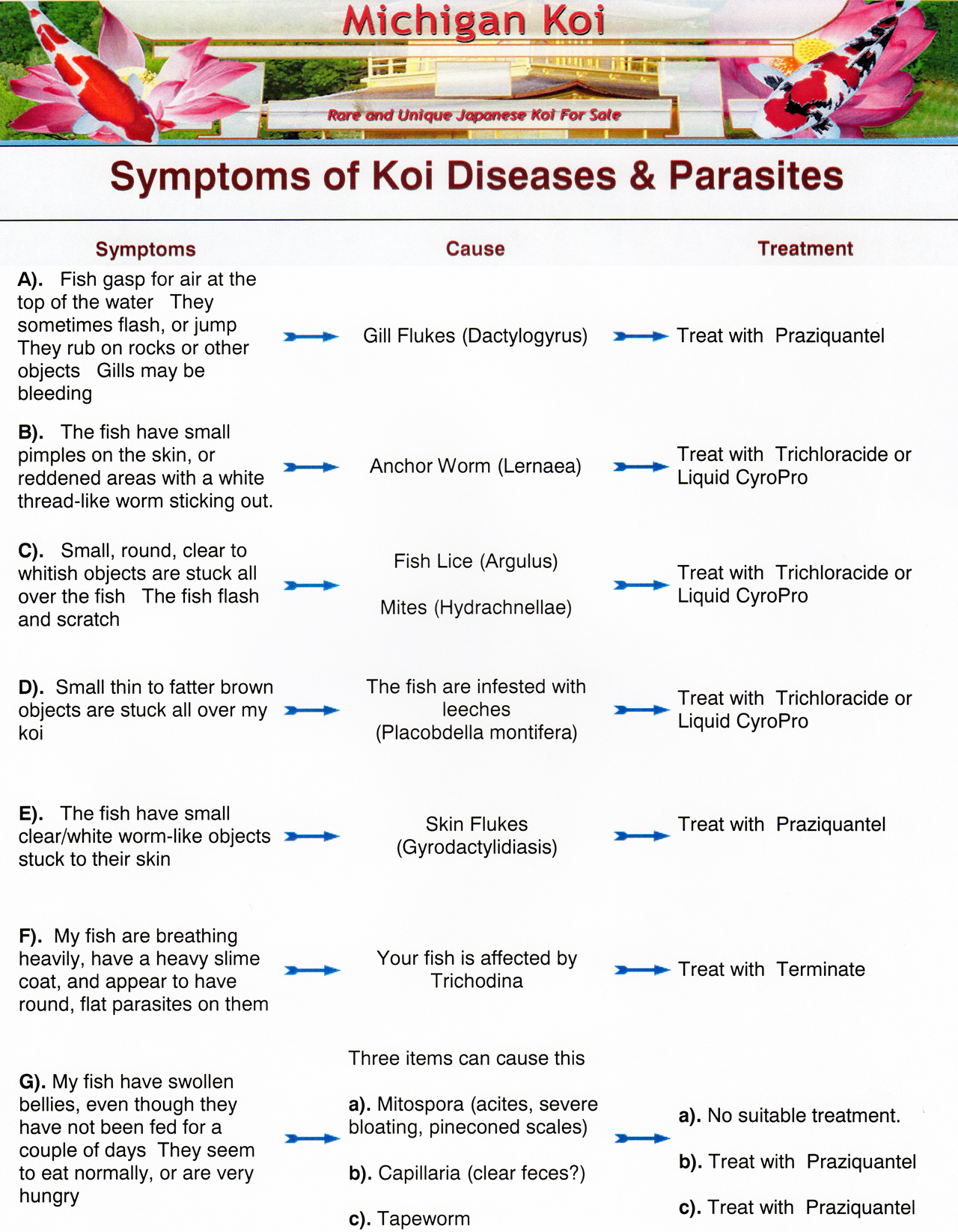Koi College - Health
Nutritional Requirements of Koi
The type of food you give your Koi and the quantity you offer them will vary according to their size. The majority of proprietary Koi foods have a cereal base with different ingredients added either to enhance color or aid digestion.
Choose a food size that is small enough to be eaten by the smallest fish in the pond; otherwise, they may die of starvation. If you keep very small Koi with larger ones, offer a mixture of large and small foodstuffs, but always make sure that young fish are adequately fed.
Most Koi food comes in two forms: floating and sinking. Koi are bottom-feeding fish and are, therefore, better suited to sinking food. This is made by compressing the meal through a die at high pressure. The meal is held together with fats and, again, takes a long time to be dissolved by cold water. The disadvantage of relying on this type of food is that you will be deprived of seeing your Koi feeding.
Fortunately, Koi will take food from the surface - indeed, you can even tame your Koi to feed from your hand - and special expanded (hollow) foods have been formulated for this purpose. These are steam cooked to create an outer shell, which protects the food particle from saturation for a while. (Once the pond water has dissolved the shell, the food will sink.) Another advantage of floating food is that it is easy to see when the Koi have eaten enough. Take care when feeding sinking types - uneaten food can easily pass unobserved, particularly in murky water.
Provide just enough food so that after five minutes it has all been eaten. On Koi farms in summer, smaller Koi (i.e. below 15-20 cm/6-8in in length) are fed five percent of their body weight per day, where-as a large mature Koi (i.e. over 20cm/8in long) are only fed two percent. The nutritional value of Koi food is calculated by weight and not by volume. Normally, 1kg (2.21b) of fish food will increase Koi growth by 500gm or even 700gm in favorable conditions. In the winter, provide wheat germ based diets on a maintenance basis, in order to keep the body functions ticking over, since it is too cold for the Koi to grow. Wheat germ is also a good source of Vitamin E.
Feeding to enhance Koi color.
Koi are highly valued for their color and certain additives can be included in the diet to maintain and enhance the fish's natural coloration. Carotene affects the red pigmentation, but if used at too high a concentration, even the white pigment on the Koi will turn pink. Spirulina platensis also enhances and fixes the red pigment, but does not turn the white to pink to the same extent. It is a type of algae found and cultured in Mexico and eaten by the people since it contains a high level of protein. Initially, it was fed to Koi on account of its nutritional value and not because of its color-enhancing characteristics. Now that these have been established, it is fed to Koi for only one month each year, usually during September, but can be given at any time, even during colder periods, at temperatures of 10c, but no lower. Some Koi farmers feed it for the month before the fish go to the market to bring out the best colors in the Koi.
Good coloration is not only enhanced by good feeding, however. Healthy fish tend to have much brighter colors than diseased ones. To bring out the color in Koi, particularly the white, you must provide good living conditions. Strong red and yellow pigments develop well in waters rich in green phytoplankton (single-celled plants). Because Koi are difficult to see in green water, it helps to feed a diet that will enhance the red pigmentation. Black pigment is enriched in hard water with a pH level of 7.5-8.5. Remember, however, that changing the pH and hardness of the water can affect the toxicity of ammonia and nitrite.
Nutritional Content of Food
Koi food contains various elements, such as proteins, fats, carbohydrates, vitamins, and minerals, which are essential for all animals to maintain healthy bodies, grow and reproduce. Here we explain what these elements are and why they are crucial components of food.
Proteins are made up of amino acids. Thirteen essential amino acids should be included in any fish diet, although there are about 20 found in natural proteins. An adequate food contains sufficient quantities of both primary and nonessential amino acids to allow the Koi to grow, repair damaged tissue, and produce either eggs or sperm. Deficiency of protein or any of the essential amino acids causes Koi to grow more slowly and, if this dietary problem continues, can result in a deformation of the spine. (Spine deformities may have several other causes, such as disease, however).
Fats provide a source of energy to Koi; their essential role is in providing fatty acids, such as triglyceride and phospholipids, vital components of membranes surrounding all cell walls. Koi can make almost all of the fatty acids they need with the exceptions of linoleic and Linolenic acids, which are essential and must be provided in the food. Linolenic acids are required for growth.
All fats are made up in a similar way to proteins, but of fatty acids, rather than amino acids, bonded together with glycerol. If essential fatty acids are omitted from the diet, symptoms of fin erosion, and heart and liver problems may result. Fats have a low melting point and are thus more easily digested by Koi. They are found in fish, soy oils, and high concentrations of wheat germ. Fatty acids become rancid on exposure to air - a chemical process known as oxidation. In Koi, the liver is the chief organ for storing fats, and if stale food is fed to them, it can result in disease and death. Unfortunately, rancid food has no outward appearance of having 'gone bad'. It is, therefore, worth buying smaller packs of food, rather than a large quantity which is utilized slowly and never keep food from one year to the next.
Carbohydrates also form a source of energy for Koi, but fish metabolize them less readily than omnivorous birds or mammals. Too much carbohydrate is very bad for koi health, resulting in either degeneration of the liver or excessive storage of these substances as glycogen, leading ultimately to heart failure.
Vitamins are essential for the healthy metabolism and growth of Koi, and the requirements of some are increased during spawning. Vitamins are complex-structured substances needed in only small amounts in the diet, but deficiencies can cause clinical disorders.
Vitamins are divided into two categories: fat-soluble and water-soluble. Fat-soluble vitamins are found in a variety of forms, all of which are metabolized slowly and can be stored in the body fat. An excess of fat-soluble vitamins can lead to a condition known as hypervitaminosis, which, depending on the vitamin, can lead to clinical disorders. Water-soluble vitamins are easily absorbed and are not usually excreted.
All essential vitamins are supplied in more than adequate quantities in proprietary koi foods, and it would be unusual for the hobbyist to meet clinical symptoms associated with deficiency.
Minerals, too, aid essential metabolic functions, as well as performing their duties, which include building skeletal structures, osmoregulation, the building of nerves, and maintaining the efficiency of gaseous exchange in the blood system. Little is known about mineral deficiencies in fish, probably because most minerals are absorbed from the surrounding water. Typically 12 percent of the diet is made up of minerals, being contained in fish food in the form of ash.
Read more on Koi food ...Click https://michigankoi.com/product/healthy-koi-fortified-fish-food/

Feeding and Growth Rate
Feeding and Growth Rate
The feeding pattern, and thus the growth rate, of Koi, depends on many factors, such as water temperature, water quality, stocking density, and genetic background Koi feed most actively at temperatures over 15c(59F). Thus sexually immature fish can grow rapidly during the summer months when the temperature is warmer.
Once Koi are mature, their growth rate slows considerably; in sexually mature fish, most of the food eaten is utilized in producing eggs or sperm in preparation for breeding. However, unlike many other vertebrates, fish continue to grow throughout their lives, and it is easy for pampered Koi to reproduce and continue to grow because of their artificially high feeding rates.
The cycle of rapid growth in summer and retarded growth in winter produces rings on the fish's scales (much like the growth rings of a tree), and a koi's age can be determined by counting these rings. Some koi-keepers, however, who heat their pools in the winter, continue to feed their Koi throughout the year. If a Koi has continued to feed during winter, its rings will not be clearly defined, and it will, therefore, be difficult to age.
Water Temperature and Feeding
Water temperature affects fish more than any other single factor. Fish are ectothermic - their body temperature fluctuates in accordance with the temperature of their environment, usually remaining 10C higher.
As the temperature drops, the ability of the Koi to digest and assimilate food decreases. In the winter months, therefore, at temperatures below 10C(50F), it is a good idea to feed cereal diets that the Koi can digest quickly and easily and that do not stay in the gut too long. High-protein foods linger in the gut and can cause severe problems; the bacteria found in the fish's gut, which play a role in breaking down some less readily digestible substances, such as cellulose, may become pathogenic if food is retained in the intestine too long.
As the water temperature rises, however, the Koi need protein for growth, repair of damaged tissue and injuries, and for reproduction. In the summer, Koi will benefit from a high-protein diet containing 35 to 40 percent of fishmeal-based protein.
How Many Koi Can I Have?
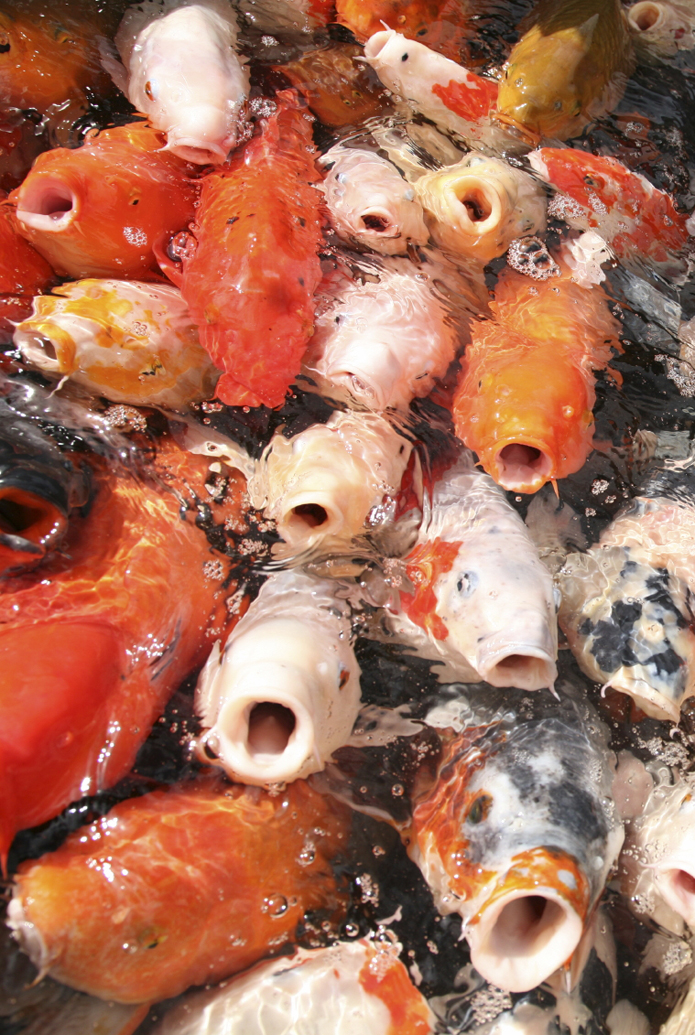
Filtration is going to be the most important factor in determining the number of Koi you can have. It is more important then the number of gallons. Many store bought filters will tell you they can filter 1000 gallon ponds or 2000 gallon ponds. These ratings are never accurate. They base these on the assumption that you will have very few fish, usually only two or three goldfish. Just because you have a 1000 gallon pond and you bought a filter for 1000 gallon doesn't mean you can put 20 Koi in there and expect great water quality. As a general rule, cut the number of gallons the filter says it can filter in half, and even then keep the stocking density low. But you can have four; 25 inch Koi in 1000 gallons IF the filter is large enough to handle the waste produced...both solid and ammonia. The key to deciding if you are over stocked is water testing. If you have ammonia that simply won't go away, or waste and debris in the water, then you are over stocked for the size of the filter. To correct this you need to either cut back on feeding, reduce the number of fish or increase the size of the filter.
Another major consideration is circulation. A Koi pond with poor circulation will have a lot of trouble at higher stocking densities. The reason is the filter cannot treat waste it doesn't come in contact with. You need to circulate the ponds entire volume every hour. And that does not just mean a 1000 gallon pump for a 1000 gallon pond. You need to make sure there are no "dead spots" in the pond where water does not flow properly. If you notice certain areas of the pond have more debris settling then others, then you need to correct the circulation. A bottom drain is the best way to prevent poor circulation. Skimmer only ponds will be plagued with poor circulation and stocking density should be kept very low. You can add small underwater jets or air diffusers to help circulate the water.
The type of food and the amount you feed also play a major role in the stocking density. Low quality foods have fillers and low digestibility. This means more waste for the filter to handle. Also, the more you feed them the more waste the Koi produce. So feeding heavily with cheap food means you need to keep a very low stocking density. This is not to say you should not feed the Koi. But rather if you want to feed heavily to get maximum growth and development you need to use only high quality foods and keep a low stocking density with a large enough filter to handle the waste from such a heavy feeding routine. Again it comes back to what you want from your Koi.
Aeration is also major factor in stocking density. The bacterium in the bio filter is highly oxygen dependent. If you do not have enough O2 saturation in the water then the bio filter will not be as effective and in turn you must keep a lower stocking density. Another thing to keep in mind is during the warmer months the water will not hold as much oxygen and this is also the time the fish are eating the most so your bio filter needs to be at its peak. That means it needs as much O2 as it can get. Luckily aeration is one of the easiest things to correct. An air pump with an air diffuser and air stones can correct this problem very quickly. It will also help with your circulation by bringing the water from the bottom of the pond back to the top... remember: it’s a system and all the parts work together.
The last thing to consider is how much time you want to spend cleaning filters, testing the water, doing water changes, etc. If the maintenance becomes too much of a chore then after awhile it won't get done and the water quality will suffer. Heavy stocking densities require more time and effort. If you want to spend less time working on the pond and more time enjoying it, keep the stocking density low, vortex settling chambers and bio-conversion chambers big, and use aerated bottom drains! After these requirements are met, only then: 1 inch of fish to 10 gallons of water, (example: 100 inch of fish for each 1000 gals. or 4 large 25 inch Koi per 1000 gal. pond water.
What Is The Value of My Koi ????
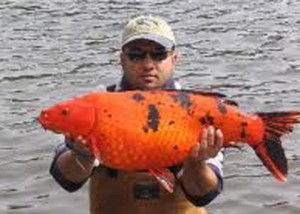
The way it works is like this. The breeder starts with say 100,000 koi from a single female. From that 80,000 never get sold, they are destroyed or turn into food. These usually have no color or they are deformed in some way. They take the 20,000 left and grow them for one season. At the end of the season, from those 20,000 they sell maybe 18,000 right away. They do this because they have determined that those koi will never be worth more when they are bigger. These are the koi that fill the $10, $30 and $50 tanks at the dealers shop. The remaining 2000 they keep because they feel they will be worth more next year. So the little koi you buy, they are from those first 20,000 meaning in the top 20% of the spawn, but were sold small because they lacked potential. That doesn't mean they are ugly, far from it. There are many beautiful little koi that will make wonderful pond pets. But from a financial point of view, these koi are not worth growing another year at the breeders. Growing pond space is too valuable to waste on koi that will not gain value.
So then we are left with the 2000 koi they decided had potential to become more valuable. The next season they pull them up and sell maybe 1800 of them as Nisai (two years old). Again these are koi they feel have reached their full potential and will not be worth more later on, so they are sold. But remember, these koi were all higher quality then the rest and represent 2% of the entire spawn and two seasons of hard work. So they sell for a much higher price. Usually these will be the koi in the $200 to $800 range but some of the best will be sold for much more.
However the 200 that are kept another year are the absolute very best and represent .2% of the original spawn. They are grown for yet another year and perhaps 180 of them are sold as Sansai (three years old) at a much higher price, usually several thousand dollars. Then a year later the last 20 are left and perhaps 18 of those are sold for an unbelievable amount of money. The best one or two are usually entered in the All Japan Koi Show and frequently held for future breeding.
So as you can see, it is not likely that one of those first koi that sold for around $20 could ever be worth as much as those that were held by the breeder for years. Those large koi being sold for the big bucks not only had a lot of potential as a young koi, but were also raised in the superior environment of the breeders mud ponds. These ponds are ideal for koi and allows for maximum growth and color development. Koi that spent their lives in a small backyard pond simply can't compare. Sure every now and then a lucky little koi slips through the breeders culling and finds it's way into a superior hobbyist pond and they end up with a $2000 koi years later, but that doesn't happen very often. Odds are, if the fish holds its pattern and develops a nice body, it will be worth about what you paid for it even though it is 10x bigger. Sorry, but just because you have a bunch of large koi that doesn't mean you are sitting on a retirement goldmine. If you want a high quality valuable koi, then you will need to buy one.
Quarantining Your Koi
Why should you quarantine your new fish?
New fish can be carrying parasites, and in rare cases systemic infections (internal problems) and although the Japanese breeders and Koi dealers normally treat fish when they first arrive, there is no guarantee that problems will not occur after you have purchased your Koi.
However, bear in mind that the vast majority of Koi are strong and healthy when they are first harvested in Japan, and are not riddled with parasites or infection.
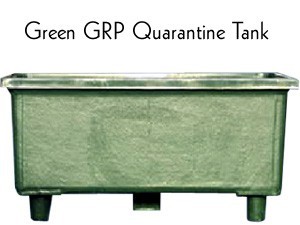
Most problems occur because of the induced stress of up to 24 hours in a plastic bag during transit, and because of substantially differing water conditions, in particular pH and general hardness.
The induced stress of their long journey and radically different water quality can inhibit the immune system response in new Koi. This can lead to parasite attacks, and ultimately bacterial infections. During the journey, your new Koi has almost certainly been subjected to water temperature changes of 15 deg. C over a 24 hour period which adds to the stress problem.
Therefore, rather than treating problems after they occur, we need to get the Koi 'comfortable' in their new environment as quickly as possible, to ensure that their own immune system is working properly, so that they can fight of any potential problems without human intervention.
The most important thing that new Koi need when they first arrive is prime quality water and a few days rest to settle in to their new environment.
The last thing Koi need having spent up to 30 hours in a plastic bag and in a stressed state is to be dumped in potassium permanganate, malachite or anything else nasty.
The only 'additive' you may want to consider is salt at 0.5 oz per gallon with Elbagin as a supportive treatment in the pond to overcome stress and get them get used to the new water conditions.
Other than this all they need is good water, and plenty of it. Many people run into problems quarantining fish in a vat or pond which is too small.
Your quarantine facility should be minimum 1000 gallons with temperature control and a mature filter. Setting up you quarantine facility 3 weeks before the fish are due to arrive is asking for trouble.
Over Coming Aeromonas Alley

36340 Harper Ave. Clinton Township, MI. 48035 Office: (586) 790-8013
Cell: (586) 489-0783
Over Coming Aeromonas Alley
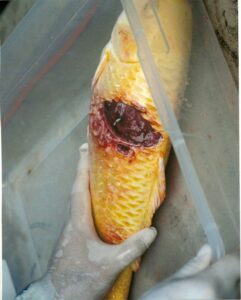 Published: By Luther C. Chien
Published: By Luther C. Chien
Retired DuPont Corporate Science Fellow
Every hobbyist knows that Spring is a critical time for koi. Often the koi get sick grow ulcers, develop fin rot and die. After a long winter of fasting, the fish are naturally weak and immunilogically stressed. Fish, like reptiles, are cold blooded animals that rely totally on their environment to function. As the temperature warms up, the fish are slowly adapting to their new environmental conditions. Preying parasites and Aeromonas bacteria are growing rapidly, and the stressed fish become their helpless victims. Why then, don't the fish suffer the same consequences in the fall when they are exposed to the same temperature ranges? I believe the reason is that the fish have been building up their immunity all Summer and are at the peak of health so they are better conditioned to fight off diseases, besides, the biofilter are also at their optimum, so the water conditions are at their highest quality. Reference 12 supports my theory, in that it finds, once carp have been immunized at a higher temperature (77°F), they can respond better immunilogically to lower temperatures (50°F), and also possess immunological memory. My studies over a two year period reaffirm the hypothesis, that pond temperature plays a critical role in the health, growth, and immunity to disease. Even with ideal water conditions, the fish can still get sick. Especially if, they carry traces of the Aeromonas bacteria in their internal systems, and the temperature of the water favors the undesirable bacteria instead of the fish. I have developed a cross plot that illustrates my point in Figure 1. The data is based on References (10, 11,12 13 ) and contributions of D Pakiser and L Jepson References (2.9)
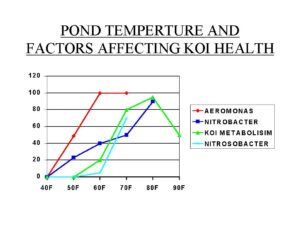 A study of Figure I shows the following:
A study of Figure I shows the following:
Aeromonas bacteria are basically inactive at 40°F.Their activity increases exponentially with every degree rise, culminating at the maximum activity at 60°F.
Koi start building immunity only after 55°F.One researcher found no white blood cells below 55°F.The optimum temperature for carp is stated to be 77°F.
NOTE: Carp will die once exposed to 95°F.
Activity of the biofilter is also temperature dependent. The activity of Nitrobacter (the bacteria that converts ammonia to nitrites) , is non existent at 40°F. It rises to only 50% activity at 60°F.It is fully active at 75°F.The Nitrosomonas bacteria (the bacteria that converts nitrite to nitrates) is not active until 60°F.
In summary, within temperature ranges of 47°F to 62°F the Aeromonas bacteria run rampant while the fish are barely beginning to reestablish their immunities. To compound these undesirable conditions, the biofilter are only marginally active. As a consequence, ammonia and nitrites are both likely to be above the desirable range. This temperature range that is hazardous to fish is commonly referred to by the pros as the "Aeromonas Alley".
How long are we forced to expose our fish to the temperature range of Aeromonas alley? In an effort to answer this question, I kept daily records of my pond temperatures in Pitman N.J. for the entire year of 1997. I measured the temperature at noon every day, ignoring the evening drops. My data is plotted in simplified form, in Figure II. I also show the maximum temperature swings each month through out 1997. The results surprised me! My pond was in the Aeromonas alley temperature range, almost 3 months! Furthermore the largest temperature fluctuations occurred in May, June, and July. The fluctuations were also high in November, fortunately, I had already stopped feeding the fish.
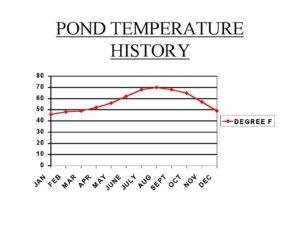 How long are we forced to expose our fish to the temperature range of Aeromonas alley? In an effort to answer this question, I kept daily records of my pond temperatures in Pitman N.J. for the entire year of 1997. I measured the temperature at noon every day, ignoring the evening drops. My data is plotted in simplified form, in Figure II. I also show the maximum temperature swings each month through out 1997. The results surprised me! My pond was in the Aeromonas alley temperature range, almost 3 months! Furthermore the largest temperature fluctuations occurred in May, June, and July. The fluctuations were also high in November, fortunately, I had already stopped feeding the fish.
How long are we forced to expose our fish to the temperature range of Aeromonas alley? In an effort to answer this question, I kept daily records of my pond temperatures in Pitman N.J. for the entire year of 1997. I measured the temperature at noon every day, ignoring the evening drops. My data is plotted in simplified form, in Figure II. I also show the maximum temperature swings each month through out 1997. The results surprised me! My pond was in the Aeromonas alley temperature range, almost 3 months! Furthermore the largest temperature fluctuations occurred in May, June, and July. The fluctuations were also high in November, fortunately, I had already stopped feeding the fish.
The sixty four dollar question is; how does one avoid the Aeromonas alley temperature range this Spring? I had several choices;
1. Cut the feed to the fish drastically for the entire spring. I rejected this option, because I could starve my fish, thus defeating my objectives, as well as, slow down the growth of the biofilter.
2. Add Amquel as needed. I rejected this option as too expensive as well as a poor long term solution.
3. Vaccinate each fish. After reading about the huge effort expended by others to net each fish and then inject them, I decided against this alternative because I had no help, and I felt it was too expensive, and I was fearful of damaging my fish and subjecting them to further stress.
4. Use other means to kill the Aeromonas bacteria. By using oxy-generators now on the market known as (OxyClear, Nature Plus). I had worked with an OxyClear unit last year and learned how to operate it with success. Over a 3 month period, I found it did, indeed, remove all traces of ammonia and all kinds of bacteria, including the active bacteria that the biofilter requires to function.
NOTE: I found it was tricky to balance oxy-generators with my filtration system so that I could benefit from it, without destroying my biofilter. But, that is another story which I will discuss in a future article. In any event, I rejected this option, because, I believed that removing the Aeromonas from the water would have little or no effect on sick fish, that already carried the infectious disease internally. In fact, last year I did have a sick fish even while operating the oxy-generator device. 5. Feed treated fish food with antibiotics or immunity boosting chemicals. I did not favor this option, because, the sick and stressed fish might not eat or ingest the treated food.
How then did I overcome this systemic puzzle? This year, after studying the 1997 data in Figure II and the curves in Figure I, I came to the conclusion that the best solution was to minimize the time my pond was in the Aeromonas alley temperature range. I reasoned that the fish could withstand a 15°F to 20°F temperature rise, provided, I could accomplish the increase within a week. The key was to raise the temperature at a rate, which would not stress the fish. I finally arrived at a plan to raise the temperature, 1 to 2 degrees each day. To accomplish these objectives, I had to install a heater to control my pond temperature.
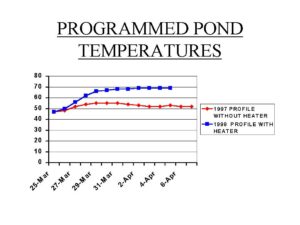
Michigan Koi.
Figure III shows the temperature record of my pond during this experiment. I started raising temperatures March 25, finally reaching my goal temperature of 65°F by March 31. For comparison, I have also plotted the pond temperature experienced during the same period in 1997. You can see that, if I had not taken this drastic step, the pond would have been in the undesirable temperature range during the whole test period. Without pond temperature control, you are leaving the fate of your fish to the whims of the elements. This is precisely the predicament many of the West Coast hobbyists found themselves in this year because of the El Niño weather phenomena, the temperature rose for a few days, then dropped precipitously, causing many west Coast ponds to cycle through the Aeromonas alley temperature range. Needless to say, there were a large number of sick and stressed fish. My conclusion is that, you need control over pond temperatures even in mild climates.
After solving the temperature question, the next question is how much feed should one start with? Feed is needed to build fish immunity and produce ammonia to grow the Nitrobacter in the biofilter. Overfeeding will surely result in undesirable ammonia levels, especially if, the biofilter are not yet fully active. The way I arrived at a satisfactory solution, was to assume that the filters were totally inactive, and then, calculate the minimum feed for a week, so as, not to exceed the maximum tolerable level of ammonia. Having calculated the acceptable amount, I then proceeded to feed that amount over a week, while monitoring ammonia and nitrite levels. I followed this plan and had no problems, so I continued the same program the second week. The third week I reasoned that the biofilter were probably operative, and increased feed on demand while still monitoring the water.
Here is how I calculated the minimum feed level;
Max Tolerable Ammonia = Food Fed x Ammonia Generated per Lb.
Volume of Pond
Reference 1 states that one pound of 35% protein food will generate 14gs of ammonia. It also states that the maximum tolerable ammonia is 0.08 mg/liter. Since my pond has 10,000 gallons, and converting all units to milligrams and liters then;
0.08=Food Fed x 1,000 x 14/454
10,000 x 1/0.26 (liters/gal.)
Solving for food fed gives;
Food Fed = 0.08 x 10.000 x 454
*0.26 x 1,000 x 14*
The result is 99.9 grams. During my tests I used exclusively Dianichi All Seasons food. Feeding a proper diet is essential during this critical period to insure maximum fish immunity build up and growth.
Now I would like to describe the heater system I used to control my pond temperatures. After considerable thought, I chose to use a hot water circulation system. It was not only simple, but easy to install, and maintain.
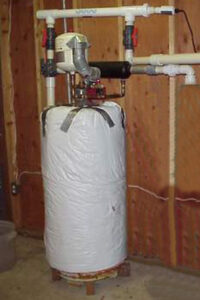 Furthermore, it was inexpensive, when compared to the swimming pool heater systems. Swimming pool heaters are large and generally not suitable for fish ponds. The copper tubes inside the units are severely attacked by the salt in the brackish pond water. A special unit can be made to order, using stainless steel or cuprous nickel alloy tubes. Because of the extra expense, the manufacturers prefer not to make these units in smaller than 100,000 BTU/HR sizes. These units are much too big for ponds smaller than 10,000 gallons. Besides, my experience over 40 years of chemical plant operations predicts that the stainless steel will eventually fail in salt water via stress cracking. Copper alloy will stand up to corrosion, but will eventually foul, because of deposits of solid waste products dissolved in the pond water on the metal surfaces. The direct fired tube surfaces are heated close to boiling temperatures of the pond water, resulting in precipitation of solids, followed by baking of thick solid crusts on the surfaces, thereby significantly decreasing the heat transfer. Hot water heaters don't have this problem because heated tap water has little or no dissolved solids. The heating system I used is described in detail in the two articles in References (5,6). Basically, the system utilizes hot water supplied by a conventional hot water heater, circulating through a stainless steel heat exchanger to heat the pond water. The circulation rate controls the pond water temperature using a thermostat and switch to control the circulating pump. A ballast tank is needed to take care of liquid expansion in the closed system. The size of the pond and the temperatures desired, dictate the size of the heat exchanger and necessary boiler.
Furthermore, it was inexpensive, when compared to the swimming pool heater systems. Swimming pool heaters are large and generally not suitable for fish ponds. The copper tubes inside the units are severely attacked by the salt in the brackish pond water. A special unit can be made to order, using stainless steel or cuprous nickel alloy tubes. Because of the extra expense, the manufacturers prefer not to make these units in smaller than 100,000 BTU/HR sizes. These units are much too big for ponds smaller than 10,000 gallons. Besides, my experience over 40 years of chemical plant operations predicts that the stainless steel will eventually fail in salt water via stress cracking. Copper alloy will stand up to corrosion, but will eventually foul, because of deposits of solid waste products dissolved in the pond water on the metal surfaces. The direct fired tube surfaces are heated close to boiling temperatures of the pond water, resulting in precipitation of solids, followed by baking of thick solid crusts on the surfaces, thereby significantly decreasing the heat transfer. Hot water heaters don't have this problem because heated tap water has little or no dissolved solids. The heating system I used is described in detail in the two articles in References (5,6). Basically, the system utilizes hot water supplied by a conventional hot water heater, circulating through a stainless steel heat exchanger to heat the pond water. The circulation rate controls the pond water temperature using a thermostat and switch to control the circulating pump. A ballast tank is needed to take care of liquid expansion in the closed system. The size of the pond and the temperatures desired, dictate the size of the heat exchanger and necessary boiler.
The heat exchanger manufacturer offers the following method to determine the heating requirements;
Heat Loss (BTU/HR) = 12 x Pond Surface (square ft) x (Pond T-Outside T)
Assume a pond of 3,000 gal. With a surface of 100 square ft Desired pond T of 65F and outside T of 45F,then the calculation follows;
Heat Loss = 12 x 100 x ( 65-45) =24,000 BTU/HR
This is the heat required to maintain the desired temperature Now if you desire to heat the pond at a rate of 1F per hr., then , you need to add additional heat calculated as follows;
Heat Gain = Lbs of Water in Pond x Heat Capacity of Water For the same pond this equation becomes;
Heat Gain = 3,000 gal x 8.3 lb/gal x 1 BTU/lb/HR =24,900 BTU/HR
The boiler needed to do both jobs is the sum of the two requirements or;
24,900 +24,000 = 48,900 BTU/HR. On the other hand if you only wish to raise the pond temperature by only 1F per day then the total requirements become ; 24,900/24 + 24000 =1,400+ 24,000 = only 25,400 BTU/HR!
For my 10,000 gal pond, I only needed a 40,000 BTU/HR hot water heater , which I bought for $140 at Home Depot. The heat exchanger needed was only one square foot.(the smallest heat exchanger I could buy ).
In conclusion: I advocate installation of a heater in your pond to control temperatures in the spring , I am not advocating maintaining high temperatures all winter long. Controlling temperatures in fish tanks is not new, it is routinely practiced by all who raise tropical fish. Koi are mistakenly grouped with goldfish and carp and most new hobbyists think koi can endure anything.. The fact of the matter is , that koi are unique, they are highly interbred and as a result , genetically weak. We must treat our koi with tender loving care! TAKE STEPS NOW, TO CONTROL YOUR POND TEMPERATURES! Avoid the disastrous effects of unanticipated temperature swings next Spring! Healthy koi need a STABLE ENVIRONMENT outside the AEROMONAS ALLEY!
References for this article gathered from:
1. Aquatic Eco Systems Sales Catalogue,1998, p(373)
2. Winterizing Your Pond; D Pakiser, Koi USA,Vol.22,Issue 2 p (62)
3. Beginners Class, F Prince-Lies, Koi Health Quarterly,Issue12,p (15-17)
4. Health or Disease-It. s a Fine Balance , T Roberts, Koi Health Quarterly Issue 6 ,p (7)
5. Heating Your Pond, N Guedalia, Mid Atlantis koi, March 1997,p (39-410
6. Efficient Koi Water Heating Using Your Gas Water Heater, L Lunsford. Mid Atlantic Koi,Nov-Dec,1996 p (28-30)
7. Koi Health and Disease, Erik l Johnson DVM 1997, p (137)
8. Body Ulcers in Koi, Erik l Johnson DVM ,Koi Health Quarterly, Issue 9 p(9)
9. Thermoregulation in Koi ,L Jepson, Koi Health Quarterly, Issue 15 p (36)
10. Immune System of Cyprinid Fish; Kinetics and Temperature Dependence of Antibody Producing Cells in Carp, G T Rijkers, E H Federix-Wolters,&W B Van Muiswinkel , Immunology 41, p (91-97)
11. Minimum Water Activity for Growth of Aeromonas-Hydrophilia as Effected by Strain Temperature and Humectant, J Santos, M Lopez, M C Garcia Fernandez, A Otero ,Letters in Applied Microbiology,1994,Issue 2 p (76-78)
12. Comparative Immunology , Edwin L Cooper,p (241-245)
13. Temperature Effect on Antibody Production and Immunological Memory of Carp, R R Avtalion, Immunology, 1996, 17 p (927)
14. Preferred Temperatures for Some Invertebrate Ectotherms ,Chapter 5 , p (134) Comparative Animal Physiology, A Withers,1992.
Edited for this publication by: William Risher
Koi Diseases and Treatments

36340 Harper Ave. Clinton Township, MI. 48035 Office: (586) 790-8013
Cell: (586) 489-0783
Koi Parasite Types
Monogenea
Monogenea are small parasitic flatworms mainly found on skin or gills of fish. They are rarely longer than about 2 cm. A few species infecting certain marine fish are larger and marine forms are generally larger than those found on fresh water hosts. Monogynies lack respiratory, skeletal and circulatory systems and have no or weakly-developed oral suckers. Monogenea attach to hosts using hooks, clamps and a variety of other specialized structures. They are often capable of dramatically elongating and shortening as they move. Biologists need to ensure that specimens are completely relaxed before measurements are taken. Like all ectoparasites monogeneans have well developed attachment structures. The anterior structures are collectively termed the prohaptor, while the posterior ones are collectively termed the opisthaptor. The posterior opishaptor with its hooks, anchors, clamps etc. is typically the major attachment organ.
Like other flatworms, Monogenea have no true body cavity (coelom). They have a simple digestive system consisting of a mouth opening with a muscular pharynx and an intestine with no terminal opening (anus). Generally, they also are hermaphroditic with functional reproductive organs of both sexes occurring in one individual. Most species are oviparous but a few are viviparous. Monogenea are Platyhelminthes and therefore are among the lowest invertebrates to possess three embryonic germ layers—endoderm, mesoderm, and ectoderm. In addition, they have a head region that contains concentrated sense organs and nervous tissue (brain).
Treatment: Praziquantel as Prolonged immersion 10 g to each 100 gal.
Anchor Worm
Crustacean parasite, Lernaea - Anchor worm is a common parasite on our Koi which is clearly visible to the naked eye and can reach 10 to 12mm. The parasite burrows its head into the Koi's tissue, under a scale and only the body and tail are normally visible. The juvenile stages settle in the gills of Koi, when they mature they mate and the male leaves the Koi, the fertilized female settles on the body of the Koi and continues to grow, becoming the familiar worm shape. The female buries into the skin and underlying tissue to hold on. The damage caused can become a target for bacterial or fungal infection which can spread. Lernaea lay eggs which can lay undetected in the pond and can hatch when conditions and water temperatures are right. Treatment is by manual removal of the parasite with tweezers under anesthetic, ensuring that the whole parasite is removed. To be sure of complete removal, dip a cotton bud in strong potassium permanganate solution and dab the worm with this solution where upon it will release its grip immediately. Other recommended treatments include Trichloracide or Liquid CyroPro
Costia
Costia is a minute Flagellate with 3-4 flagella. It affects both the skin and gills of Koi, and reproduces itself by binary fission. Infestations of this parasite can appear very rapidly indeed, and Koi suffering infestations exhibit the classic symptoms of lethargy, clamped fins, rubbing and flashing and the skin can take on a grey white opaqueness. Costia normally only affects fish that have already been debilitated by some other cause, and can often be seen on Koi as a secondary parasite. A high magnification must be used to view these parasites (300 x) and staining is recommended for positive identification.
Recommended treatments include Potassium Permanganate, or ProForm-C.
Fish Lice (Argulas)
Argulus another crustacean parasite, round and up to 1cm wide. They have a sucker to hold on to the Koi with needle-like mouth parts which they stick into the Koi and inject a toxin. This causes intense irritation to the Koi and they scratch and jump and can cause bacterial infection. If they infect the gills they cause severe damage and often death.
Pond treatments include Trichloracide or Liquid CyroPro
Skin and Gill Flukes
Gill and Skin flukes are two of the family of monogenetic trematode genera, all of which are characterized by the large grappling hooks which are used to attach themselves to their victims. Flukes are another common parasite affecting our koi are both egg layers and live bearers. They range from 0.05 to 3.00mm long and there are actually a huge number of species in the genus.
Affected Koi often exhibit classic signs of irritation and flash, jump or rub themselves against objects in the pond in an attempt to rid themselves of their attackers. Flukes are not visible with the naked eye. When viewed under a microscope, the parasites are clearly visible as nearly transparent and worm like, and the hooks are clearly visible. Flukes are a bit like fleas on dogs and cats and it is common to see one or two on a slide as a healthy Koi can control parasite numbers and their mucus helps prevent the parasite moving. Treatment is therefore only necessary if flukes are seen in numbers.
Recommended treatment: Praziquantel follow up with BGDX
Trichodina
Trichodina is one of the easiest protozoan parasites to detect under the microscope as it is almost perfectly round with hundreds of hooks which resemble cilia found its periphery and it constantly rotates as it moves through the mucus, causing tissues damage. It attacks both skin and gill tissues of our Koi, and can often cause more damage to gills than realized. Classed as a warm water parasite, it can survive for some time without a host. It causes vegetation of the skin giving rise to a grey white opaque appearance on the body of infected Koi which exhibit the classic symptoms of flashing, rubbing and lethargy.A magnification of 100 to 200 x is required to view this parasite.
Recommended treatments are Potassium Permanganate, or ProForm-C. follow up with BGDX
Gill Maggots
Gill maggots are the mature females of the parasitic crustacean Ergasilus. Ergasilus (gill maggots) will appear as grayish black and white parasites several millimeters long infesting the gills. Heavy infestations can cause severe damage, eroding the gill filaments and allowing secondary infections to develop.
Recommended treatment: ProForm-C follow up with BGDX
White Spot (Ich)
Caused by Ichthyopthirius multifiliis. The white spots on the skin, gills and fins are individual protozoan cells that are under the skin and feed on the body fluids and cells. They then punch out of the skin and fall to the bottom of the pond, collect together and begin breeding, the offspring then re-invest the fish. As well as white spots symptoms are scratching and swimming into the water inlet, failure to feed and lethargy. It is fatal if untreated. Fortunately commercial white spot remedies are widely available. Recommended treatment. ProForm-C
Common Bacterial Disease
Cotton Wool Disease
Columnaris (Flexibacter Columnaris) or Cotton Wool Disease is another bacterial infection. The common name comes from the white tufts that develop around the mouth and spread to the body and fins, often leading to ulcers and a thin appearance. Often mistaken for a fungal infection because of its mold-like lesions, Columnaris is a common bacterial infection in cultured fish, particularly live bearing fish and catfish. Its name is derived from columnar shaped bacteria, which are present in virtually all pond environments. The bacteria are most likely to infect fish that have been stressed by such conditions as poor water quality, inadequate diet, or handling and shipping. Columnaris can enter the fish through the gills, mouth, or via small wounds on the skin. The disease is highly contagious and may be spread through contaminated nets, specimen containers, and even food. Treatment with anti bacterial medicine is usually effective.
Dropsy
Raised scales (rather like a pine cone) and eyes standing out from the head. Dropsy itself is not a disease, but rather a result of some other cause. Dropsy is a term given to the swelling that occurs internally in the fish. There are multiple possible causes. Sometimes it's not contagious, but sick fish should be isolated and treated since determining the actual cause may be impossible, and also because this will be easier on the fish. The fish's body will become swelled with fluid it is unable to expel. Eventually the swelling will cause the scales to rise, giving the fish what is called the "pine-cone" appearance.
Diagnosis, One of these situations may be the cause:
Sudden swelling: A bacterial infection will cause internal bleeding. Slow swelling: Growing tumors, or even parasites, in the fish may cause it to swell. Slow swelling: Mycobacterium tuberculosis. Highly contagious! Bacterial dropsy is infectious so treat with an anti bacterial remedy and if possible isolate affected Koi.
Finrot and Ulcers
A number of bacteria are associated with finrot, lesions and internal hemorrhaging, notably Aeromonas and Pseudomonas. Ulcers usually start at the site of an injury, the bacteria then infect it causing further damage, and fungal infection can also occur. Such holes result in osmoregulatory problems, leading to damaged kidneys and death if not treated. It is worth adding a weak salt solution to the pond as well as anti bacterial remedy, a concentration of 3gm per litter will help to restore the osmotic balance and reduce strain on the kidneys (make sure that the salt is fully dissolved before you add it to the pond).Finrot is easily noticeable, the fins and/or tail look chewed and are red at the edges. Secondary bacterial and fungal infections can develop.
Treatment: ProForm-C. and Ulcer Aid RX Powder
Common Fungal Infections
Saprolegnia ("Sap-ro-leg-ni-ah") Fungus
One of the most common fungal infections of Koi. The fungal spores will grow anywhere on the Koi, including the gills, initially germinating on dead tissue. Their thread like hyphae release digestive juices which break down the tissue so the fungus can absorb it, as the fungus grows these juices start breaking down living tissue Fungus on the body appears as cotton wool like growths, it is hard to tell if a Koi has it in the gills, but if it hangs at the surface gulping for air it is likely. Treatment: or ProForm-C and Ulcer Aid RX Powder
Virus
Carp Pox
Carp pox. A virus that produces solid waxy lumps on Koi. It will not kill Koi and is generally harmless, but can look unsightly. It is most often present in small Koi and in cold weather, clearing up disappearing when Koi grow and in the spring when water temperatures rise.
Koi College - Koi Health
Koi Herpes Virus (KHV)
KHV Is a very contagious, damaging and deadly disease for koi, many times causing up to 90% loss in just a few days. Symptoms can include respiratory distress, hyperactivity, loss of coordination, and severe gill necrosis. It's usually seen when the water temperature is between 70 and 80 degrees. As with most viral diseases there is no known cure. Some people have had success with heat treatment to 86F, but the carrier state of the survivors is currently unknown.
Goldfish are unaffected.
Spring Viremia of Carp (SVC)
Like the name suggests, SVC in seen only in the spring as pond temperatures are rising. It's usually seen between 40 and 60 degrees Fahrenheit.
This virus is much less damaging than KHV and currently is very rare in the . SVC produces symptoms typical of those seen with many infections and can include dropsy, hemorrhages and/ or darkening of the skin.
SVC is classified as a "reportable" disease, so a confirmed diagnosis can lead to heavy handed federal government involvement.
Injecting Koi A to Z
Injecting Your Koi
The truth is that every Koi Hobbyist will one day need to inject their Koi either with Antibiotics or with a Vaccine. Now, you could pay a vet to come to your house and inject your Koi for you, but the procedure is actually quite simple.
Anesthesia
Everyone is afraid to put their Koi to sleep. Using anesthesia on Koi is not that hard. Actually the procedure is quite simple and much less stressful on the Koi and us when we need to treat a sick Koi. We have all read articles and medical studies on Koi that show stress as a major contributor to diseases and even death. Once we have learned how to properly and safely sedate our Koi, we will be able to administer first aid a lot easier. Even though it is not difficult to perform, anesthesia is not without some risk. However, adequately and humanly treating your injured or sick Koi should be our most concern. Two types of recognized anesthesia. One is fairly cheap Clove oil or “Oil of Cloves” sometimes labeled “Eugenol.” It can usually be found in most large pharmacies and health food stores in liquid form in small bottles. The proper dose is 5-10 drops per gallon of water. Begin with 5 drops per gallon and wait about 10 minutes. If you’re Koi hasn’t rolled over on its side or is sedate enough to be worked on with little movement, add 2-3 more drops per gallon and wait ten more minutes.Another great option but a little more expensive is a product called MS-222 or Tricaine Methanesulfonate. Common brand name is Tricane-S. This is a commercial fish tranquilizer in a powder form and will have to be bought from a large pond or Koi supplier. Dose exact according to product label directions. This is a very good and safe product.
How to use Anesthesia
- First have everything you are going to need to treat you sick Koi set up and handy to begin with. You will need two containers large enough to hold your Koi and some pond water. The first container is where you will use the anesthesia and the second is to revive your Koi after treatment.
- Place enough pond water in both containers to allow the Koi to float comfortably. Do not use containers too large or you will need to use greater amounts of anesthesia. You only need enough water to barely cover the Koi. Have a cover for the container to prevent your Koi from jumping out and possibly getting injured. The net you use to catch your Koi will work fine.
- Use surgical gloves to handle your sick Koi.
- Measure the anesthesia into a small glass jar with a small amount of pond water. Shake the mixture until it is completely dissolved. Using warm water with clove oil will help emulsify the oil based product. Pour into the first container.
- Use an air stone to aerate the water in both containers.
- Carefully catch and place the Koi into the first container with the anesthesia. Cover the container. Check the time. Observe the Koi carefully through this entire process. The breathing will slow and the gill plates will slow down. It may want to struggle at first so cover the container. It usually takes about 5-10 minutes for the Koi to go under. If it seems unaffected by the anesthesia after ten minutes place additional water from the tub back into the glass jar, add some additional anesthesia (perhaps 50% of original dose) mix well and pour into the container with the Koi. You might have to do this a few times until your Koi starts to sit on the bottom and eventually it will lie over on its side breathing slowly. Larger Koi will take a little more anesthesia.
- When you can pick it up and it doesn’t want to struggle or flop around it is ready to be treated. Its gills covers will still be moving slowly.
- Keeping the sedated Koi in the water, take the time to exam its body fully. The underside can hide ulcers or other problems that are not detectable while it is swimming free in the pond.
- Any ulcers, anchor worms, etc. should be treated at that time.” I put Ulcer Aid Rx Powder directly on any wound at this time and let it soak in as I perform any other operation.”
- Ready to inject you’re Koi: Have all injections and materials prepared before sedating the Koi. Place Koi belly up, cradled on a plastic bag or wet towel. Hold the fish with one hand gently and quickly make the injection.
- With your treatment complete, now place Koi gently into the clean water container until it revives. Make sure the fresh water container has lots of aeration. Once the Koi uprights itself and starts swimming it can be placed back into your pond or tank. This normally happens very quickly when the sick Koi is placed into the clean aerated water container. Moving the Koi back and forth, to add water flow over the gills has proven helpful in reviving the Koi. Do not release the Koi until it is upright and swimming freely.
- You’re done
Injection Descriptions:
There are three injection sites on a Koi; Intramuscular (IM), Intraperitoneal (IP), and Intravenous (IV).
1 ) Intramuscular (IM) is my first choice for injection and is used if the Koi has ulcers that have broken through to the body cavity. Any medication injected into the peritoneal cavity in a fish of this condition could drain out through the ulcer. The ball muscle at the base of the pectoral fin, this is a very popular site as it does not have any scales and has a very high distribution capability, via the pectoral girdle, as the description suggests you insert the needle at the back of the pectoral fin in the ball muscle. Another popular site is under the base of the caudal peduncle, again in the tail muscle, this has the distinct advantage of, if an injection related infection sets in as a result of the injection itself, it will not show a scar, and much the same can be said of the pectoral ball muscle. Injections given into the muscle, diffuses into the tissue and then into the blood stream, then the circulation of the substance begins. The draw back to IM is that the muscle tissue of the Koi will contract and force some of the injected material to be squeezed back out the injection site.
Intramuscular (IM) is my first choice for injection
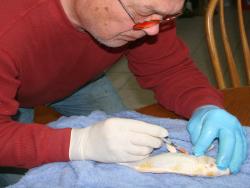 2 ) Intraperitoneal (IP) is the second most common & effective method. Antibiotics or vaccines injected into the peritoneal cavity are absorbed into the Koi’s system slowly as opposed to oral medication which will mostly pass straight through. IP injection is performed under sedation so the Koi does not thrash about. Without the thrashing, you will not lacerate an organ. In addition, with the fish relaxed & upside down, the organs tend to settle out of the way a little. You might still puncture an organ, but with the fine needle pushed in and pulled out cleanly, there will be little danger of injury.
2 ) Intraperitoneal (IP) is the second most common & effective method. Antibiotics or vaccines injected into the peritoneal cavity are absorbed into the Koi’s system slowly as opposed to oral medication which will mostly pass straight through. IP injection is performed under sedation so the Koi does not thrash about. Without the thrashing, you will not lacerate an organ. In addition, with the fish relaxed & upside down, the organs tend to settle out of the way a little. You might still puncture an organ, but with the fine needle pushed in and pulled out cleanly, there will be little danger of injury.
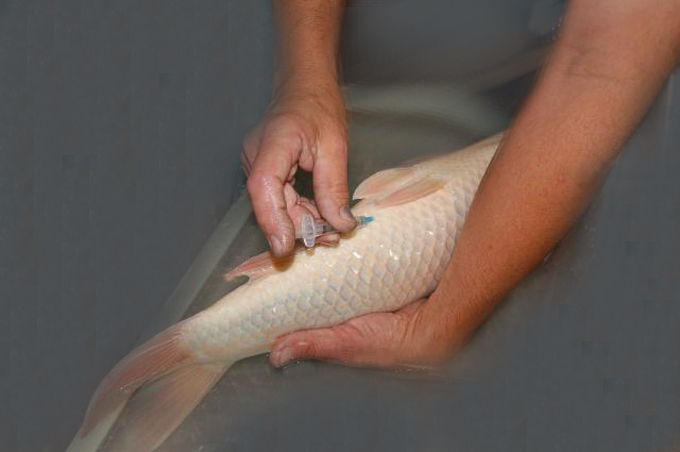 3 ) Intravenous (IV) as the name implies involves delivering the medication into a vein of the Koi; this involves an injection site under the caudal peduncle just ahead of the caudal fin. The main vein run directly under the spinal column, so the needle is inserted vertically at this point until it comes up under the spine and actually very lightly hits the spine, at this point the syringe is withdrawn away from the spine a very minute distance about 1ml the actual point of the syringe should now be in the vein. A slight pull back on the syringe plunger should draw blood into the main body of the syringe, this is an indicator that you are in the exact spot needed and at this point you should depress the plunger and deliver the medication. Although I have seen IV injection in school and have drawn blood for test, I have never injected Intravenous Antibiotics or vaccines myself. Schools warn against this type of injection and reserve it for experts and then only on really large fish. The problem is the ability to actually hit the vein which runs through the center of the fish. It is performed on the under side of the fish near the tale.
3 ) Intravenous (IV) as the name implies involves delivering the medication into a vein of the Koi; this involves an injection site under the caudal peduncle just ahead of the caudal fin. The main vein run directly under the spinal column, so the needle is inserted vertically at this point until it comes up under the spine and actually very lightly hits the spine, at this point the syringe is withdrawn away from the spine a very minute distance about 1ml the actual point of the syringe should now be in the vein. A slight pull back on the syringe plunger should draw blood into the main body of the syringe, this is an indicator that you are in the exact spot needed and at this point you should depress the plunger and deliver the medication. Although I have seen IV injection in school and have drawn blood for test, I have never injected Intravenous Antibiotics or vaccines myself. Schools warn against this type of injection and reserve it for experts and then only on really large fish. The problem is the ability to actually hit the vein which runs through the center of the fish. It is performed on the under side of the fish near the tale.
I have drawn blood for test in school, but I have never injected Intravenous Antibiotics
Eliminating air from the syringe
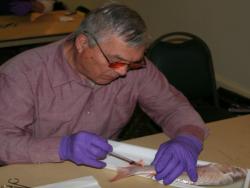 This is a very easy technique and essential, if air finds its way into the blood stream an embolism takes place end result dead Koi. After filling the syringe hold up the syringe vertical with the needle pointing upwards pull back on the plunger to create space about 2/3 ml from the top of the syringe this in effect has created an air gap at the top of the syringe, now repeatedly flick the plastic side of the syringe with your finger nail until the air bubbles in suspension in the antibiotic rise and burst on the surface of the fluid. After all evidence of air in suspension has gone, while still holding the needle vertical push the plunger up till the fluid rises out of the top of the needle and no more air can be seen, ready for injection.
This is a very easy technique and essential, if air finds its way into the blood stream an embolism takes place end result dead Koi. After filling the syringe hold up the syringe vertical with the needle pointing upwards pull back on the plunger to create space about 2/3 ml from the top of the syringe this in effect has created an air gap at the top of the syringe, now repeatedly flick the plastic side of the syringe with your finger nail until the air bubbles in suspension in the antibiotic rise and burst on the surface of the fluid. After all evidence of air in suspension has gone, while still holding the needle vertical push the plunger up till the fluid rises out of the top of the needle and no more air can be seen, ready for injection.
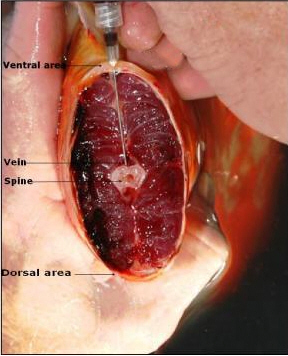 The following are injectable tables.
The following are injectable tables.
These are set forth to help Koi keepers help themselves, and to get help from their family veterinarian. Injections should never be given unless a veterinarian has approved the use, or knows the Koi keeper well.
Baytril - Enroflaxacin. A fluoroqiunolone antibiotic sold by Bayer Corporation. It is a bacterial agent. The activity of enroflaxacin is concentration dependent-which means dosage has to be precise-a major reason why some will complain that Baytril doesn't work. Susceptible bacteria cell death (gram-negative and gram-positive) occurs within 30 minutes of exposure.
Baytril injectable antibiotic is available in three strengths: 2.27%. 5% and 10%. The table below is calculated for 2.27% Baytril. Baytril in most cases should be the first injectable to use. It is powerful, forgiving, and in almost every instance healing is visible after three injections. The protocol for Baytril is three injections on consecutive days, then two more every other day (EOD) for a total of five injections. Like antibiotics for pets or yourself, it is best to follow through completely. Short-circuiting the injections will lead to Baytril resistant strains. Intraperitoneal injections are usually suggested and are the easiest and safest. Keep this product cool or refrigerate. Baytril is dated and has a fairly long shelf life.
One more thing about Baytril. There have been some cases of new imports being resistant to Baytril. While I know this may be true, it can also look like Baytril resistance when it is actually under dosing of the antibiotic. Measure carefully and refer to the charts for accuracy.
Naxcel: A broad spectrum cephalosporin antibiotic which is active against gram-negative and gram-positive bacteria. Naxcel is a powder and can be stored cold for a year or more. Once reconstituted with sterile water it can be refrigerated for about seven days, or, drawn into syringes and kept frozen for up to eight weeks. Generally available in one gram bottles. Use 20CC sterile water to reconstitute this antibiotic.
Nuflor - Florfenicol. A synthetic antibiotic which is active against gram-negative and gram-positive bacteria. It is believed to work by inhibiting bacterial protein synthesis.
Cefotan - Cefotetan disodium. Available in one gram vial for reconstitution. Rarely used in Koi. Active against gram-negative and gram-positive aerobic bacteria as well as many anaerobes, both negative and positive. This is primarily a human drug.
Azactam: Aztreonam, Systemic. Aztreonam is only effective against aerobic gram negative bacteria. It is reconstituted with sterile water (for our purposes), normally using 3CC sterile water per gram of the antibiotic. Once reconstituted it is good for about three days at room temperature or seven days if refrigerated. If drawn up in syringes and frozen the shelf life is about 30 days at which point it begins to slowly lose potency. Once thawed, it should not be refrozen.
Naxcel, Nuflor and Azactam antibiotics may be used in place of Baytril, if Baytril does not promote healing after the third injection, or if it is not available. The injection routine is the same, but some will need to be reconstituted with a saline solution or injectable water. The table reflects the different dosage amounts for each antibiotic.
1ml = 1cc
Koi length(inches)----5% Baytril-----Naxcel----Nuflor-----Cefotan-----Azactam
4"----------------------0.1-------------0.2-------0.2---------0.2---------.08
8"----------------------0.2-------------0.5-------0.5---------0.5---------.15
12"----------------------0.3-------------0.9-------0.9---------0.9---------.2
14"----------------------0.5-------------1.0-------1.0---------1.0---------.4
16"----------------------0.6-------------1.3-------1.3---------1.3---------.5
18"----------------------0.8-------------1.6-------1.6---------1.6---------.6
20"----------------------0.9-------------1.7-------1.7---------1.7---------.8
22"----------------------1.0-------------1.9-------1.9---------1.9---------.9
24"----------------------1.2-------------2.2-------2.2---------2.2--------1.0
26"----------------------1.3-------------2.4-------2.4---------2.4--------1.1
28"----------------------1.5-------------2.8-------2.8---------2.8--------1.3
30"----------------------1.7-------------3.2-------3.2---------3.2--------1.5
The most commonly used syringes are 3CC 25 gauge 5/8". Smaller ones are used on fish which are 2" to 8".
Please note:
There are other charts in published books that use weight over length for dosage rates. I do not have the chart for weight here; but I know it’s more accurate.
I suggest that the first time you try any of these injections, you ask someone with experience to help you. It is always possible to hurt or kill the Koi if the injection is not done properly.
William W. Risher MICHIGAN KOI Office: (586) 790-8013 Cell: (586) 489-0783

